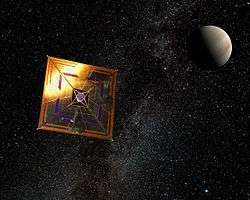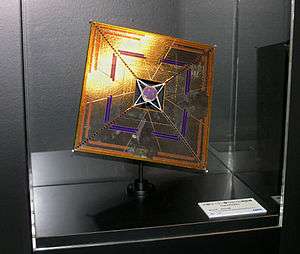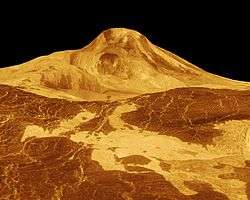IKAROS
|
A 1:64 scale model of the IKAROS spacecraft | |
| Operator | JAXA[1][2][3][4] |
|---|---|
| COSPAR ID | 2010-020E |
| Website | JAXA page |
| Mission duration |
~0.5 years elapsed: 6 years, 6 months and 15 days |
| Spacecraft properties | |
| Launch mass | 315 kg (694 lb) |
| Dimensions | Solar sail: 14 m × 14 m (46 ft × 46 ft) (area: 196 m2 (2,110 sq ft))[5] |
| Start of mission | |
| Launch date | 21:58:22, May 20, 2010 |
| Rocket | H-IIA 202 |
| Launch site | Tanegashima Space Center, LA-Y |
| Orbital parameters | |
| Reference system | Heliocentric orbit |
| Flyby of Venus | |
| Closest approach | December 8, 2010 |
IKAROS (Interplanetary Kite-craft Accelerated by Radiation Of the Sun) is a Japan Aerospace Exploration Agency (JAXA) experimental spacecraft. The spacecraft was launched on 21 May 2010, aboard an H-IIA rocket, together with the Akatsuki (Venus Climate Orbiter) probe and four other small spacecraft. IKAROS is the first spacecraft to successfully demonstrate solar sail technology in interplanetary space.[3][6]
On 8 December 2010, IKAROS passed by Venus at about 80,800 km (50,200 mi) distance, completing the planned mission successfully, and entered its extended operation phase.[7][8][9][10]
Purpose
The IKAROS probe is the world's first spacecraft to use solar sailing as the main propulsion. It plans to demonstrate four key technologies (comments in parentheses refer to figure):
- Deployment and control of a large, thin solar sail membrane (grey-blue areas numbered 3)
- Thin-film solar cells integrated into the sail to power the payload (black rectangles numbered 4)
- Measurement of acceleration due to radiation pressure on the solar sail
- Attitude control by varying the reflectance of 80 liquid crystal panels embedded in the sail (orange rectangles numbered 2)
The mission also includes investigations of aspects of interplanetary space, such as gamma-ray bursts, solar wind and cosmic dust.[11]
The probe's ALADDIN instrument (ALDN-S and ALDN-E) measured the variation in dust density[12] while its Gamma-Ray Burst Polarimeter (GAP) measured the polarization of gamma-ray bursts during its six-month cruise.[13]
If successful, IKAROS is to be followed by a 50 m (160 ft) sail, intended to journey to Jupiter and the Trojan asteroids, later in the decade.[14][15]
Design

2 (orange rectangle) Liquid crystal device, 1 of 80
3 (blue square) Membrane 7.5 µm (0.00030 in) thick, 20 metres (66 ft) on the diagonal
4 (black rectangle) Solar cells 25 µm (0.00098 in) thick
5 (yellow and blue lines) Tethers
6 (blue disc) Main body
7 (yellow dots) Instruments

The square sail, deployed via a spinning motion using 0.5-kilogram (1.1 lb) tip masses (key item 1 in figure at right), is 20 m (66 ft) on the diagonal and is made of a 7.5-micrometre (0.00030 in) thick sheet of polyimide (key item 3 in figure at right). The polyimide sheet had a mass of about 10 grams per square metre, resulting in a total sail mass of 2 kilograms, excluding tip masses, attached panels and tethers. A thin-film solar array is embedded in the sail (key item 4 in figure at right). PowerFilm, Inc. provided the thin-film solar array.[16] Eighty blocks of LCD panels are embedded in the sail,[17] whose reflectance can be adjusted for attitude control (key item 2 in figure at right). The sail also contains eight dust counters on the opposite face as part of the science payload.[18][19]
Mission progress
IKAROS was successfully launched together with Akatsuki (the Venus Climate Orbiter) aboard an H-IIA rocket from the Tanegashima Space Center on 21 May 2010.
IKAROS spun at 20–25 revolutions per minute and finished unfurling its sail on 10 June 2010.[20][21][22] The craft contains two tiny ejectable cameras, DCAM1 and DCAM2. DCAM2 was used to photograph the sail after deployment on 14 July 2010.[23]
Acceleration and attitude control (orientation) were successfully tested during the remaining six-month voyage to Venus. On 9 July 2010, JAXA confirmed that IKAROS is being accelerated by its solar sail,[24] and on 23 July announced successful attitude control. Over a 23-hour period of time, the solar angle of the sail was changed by a half a degree, not by using thrusters, but by dynamically controlling the reflectivity of the 80 liquid crystal panels at the outer edge of the sail so that the sunlight pressure would produce torque.[25]
IKAROS continues to spin at approximately 2 rpm, requiring the LCD panels to be cycled at that rate for attitude control.
According to JAXA, IKAROS finished all planned experiments in Dec 2010, but the mission has continued beyond that date "in order to enhance the skill of controlling solar sail."[26] On November 30, 2012, JAXA announced that IKAROS had been recognized by Guinness World Records as the world’s first solar sail spacecraft between planets, and that its two separated cameras, DCAM1 and DCAM2, had been recognized as the smallest size of a spacecraft flying between planets.[27][28] As in 2012, the IKAROS continue to spin, but its attitude control has degraded, resulting in unexpected sail motions and as result, downlink through medium-gain antenna being available only intermittently. The project team was dissolved in March 28, 2013, although trial receipt of data was planned later.
The project was reactivated on June 20, 2013 in the expectation that the satellite would wake up from a hibernation state as more power from the solar panels became available. The team was able to receive telemetry from the IKAROS between June 20 and September 12, 2013, after which contact was again lost. The loss of contact was around the predicted time of the spacecraft again entering a low-power hibernation mode as power from the solar panels decreased. Available communication time through the Usuda Deep Space Center antenna was limited, so data was gathered only intermittently to estimate the speed, trajectory and rotation of the satellite.[29][30] As of August 2013, IKAROS was continuing to gain speed. At that time, it had gained approximately 400 m/s of velocity from its solar sail.[31]
Transmissions were again received on May 22, 2014, the spacecraft flying at a distance of about 230 million kilometers from the Earth. By May 2014, IKAROS was on a ten-month orbit around the Sun, spending seven months of each orbit in hibernation mode due to insufficient power.[32] By April 23, 2015, the spacecraft woke up from hibernation mode for the 4th time and was flying at a distance of about 120 million kilometers from the Earth.[33] On May 21, 2015, JAXA could not receive a signal from IKAROS and concluded that the spacecraft had shifted to the hibernation mode for the fifth time, as expected. Based on May 2015 data the position of the IKAROS at the time was about 110 million kilometers away from the Earth, and about 130 million kilometers from the sun. Data showed no anomaly in the IKAROS spacecraft.[34] JAXA expects the 5th wake up of IKAROS in the northern hemisphere winter of 2015.
Science results
From the gamma-ray polarization data of GAP, Toma et al.[35] puts a stricter limit on CPT violation. It is an improvement of eight orders of magnitude over previous limits.[36][37]
JAXA scientists stated that the measured thrust force by the solar radiation pressure on IKAROS' 196 m2 sail is 1.12 millinewtons.[38]
See also
- LightSail 2, a private solar sail project of the Planetary Society
- List of missions to Venus
- Lunar Flashlight, a solar sail orbiter to the Moon
- NanoSail-D2, an American solar sail deployed in LEO in January 2011
- Solar sail
Notes
- ↑ Mori et al. (2009)
- ↑ "Small Solar Power Sail Demonstrator "IKAROS"". JAXA. Retrieved 2010-10-01.
- 1 2 Stephen Clark (20 May 2010). "H-2A Launch Report – Mission Status Center". Spaceflight Now. Retrieved 2010-05-21.
- ↑ Samantha Harvey (21 May 2010). "Solar System Exploration: Missions: By Target: Venus: Future: Akatsuki". NASA. Retrieved 21 May 2010.
- ↑ "IKAROS: Solar Power Sail Demonstrator". ISAS. JAXA. Retrieved 2015-05-24.
- ↑ "Launch Day of the H-IIA Launch Vehicle No. 17(H-IIA F17)". JAXA. 3 March 2010. Retrieved 7 May 2010.
- ↑ "今日の IKAROS(12/10) - Daily Report - Dec 10, 2010". IKAROS Blog (in Japanese). JAXA. 10 December 2010. Retrieved 22 January 2011.
- ↑ "2010年の締めくくり(12/26) - Daily Report - Dec 26, 2010". IKAROS Blog (in Japanese). JAXA. 26 December 2010. Retrieved 22 January 2011.
- ↑ 宇宙帆船イカロス、お疲れさま…実験終え「人工惑星」に (in Japanese). Asahi Shimbun. 10 December 2010. Retrieved 22 January 2011.
- ↑ Mori, Osamu (26 January 2011). "小型ソーラー電力セイル実証機(IKAROS)の定常運用終了報告" (PDF) (in Japanese). JAXA. Retrieved 2 February 2011.
- ↑ "小型ソーラー電力セイル実証機「IKAROS(イカロス)」のガンマ線バーストの観測成功について" (in Japanese). JAXA. 2010-07-14. Retrieved 2010-07-15.
- ↑ Yano, H.; et al. "COSMIC DUST DETECTION BY THE IKAROS-ARRAYED LARGE-AREA DUST DETECTORS IN INTERPLANETARY SPACE (ALADDIN) FROM THE EARTH TO VENUS" (PDF). 42nd Lunar and Planetary Science Conference (2011). Retrieved 14 February 2011.
- ↑ Yonetoku, D.; et al. (26 October 2010). "Gamma-Ray Burst Polarimeter - GAP - aboard the Small Solar Power Sail Demonstrator IKAROS". arXiv:1010.5305
 [astro-ph.IM].
[astro-ph.IM]. - ↑ "IKAROS Project". JAXA. 2008. Retrieved 12 July 2010.
The second mission will take place in the late 2010s. It will involve a medium-sized solar power sail with a diameter of 50m, and will have integrated ion-propulsion engines. The destinations of the spacecraft will be Jupiter and the Trojan asteroids.
- ↑ http://www.space.com/8800-japan-solar-sail-toast-space-science.html
- ↑ Claire M. Umali (4 May 2010). "Japan tests power of solar sails in deep space". EcoSeed. Retrieved 25 January 2011.
- ↑ "Small Solar Power Sail Demonstrator 'IKAROS': Successful Attitude Control by Liquid Crystal Device". Japan Aerospace Exploration Agency (JAXA). 23 July 2010.
- ↑ "Small Solar Power Sail Demonstrator". JAXA. 11 March 2010. Retrieved 2010-05-07.
- ↑ "IKAROS Project". JAXA. 2008. Retrieved 30 March 2010.
- ↑ Edwards, Lin (11 June 2010). "IKAROS unfurls first ever solar sail in space". PhysOrg. Retrieved 11 June 2010.
- ↑ Staff writers (11 June 2010). "Japanese Spacecraft Deploys Solar Sail". Space.com. Retrieved 11 June 2010.
- ↑ Amos, Jonathan (11 June 2010). "Japan unfurls Ikaros solar sail in space". BBC News. Retrieved 25 January 2011.
- ↑ Staff writers (16 June 2010). "Mini-camera pictures Japan's Ikaros solar sail". BBC News. Retrieved 17 June 2010.
- ↑ "About the confirmation of photon acceleration of "IKAROS" the small solar-sail demonstrating craft". JAXA website press release (Press release) (in Japanese). Japan Aerospace Exploration Agency. 9 July 2010. Retrieved 25 January 2011.
Graph suggests approx 1.1mN force
- ↑ "Small Solar Power Sail Demonstrator 'IKAROS'Successful Attitude Control by Liquid Crystal Device" (Press release). Japan Aerospace Exploration Agency (JAXA). 23 July 2010. Retrieved 25 January 2011.
- ↑ "Solar Power Sail Demonstrator "IKAROS"". Japan Aerospace Exploration Agency (JAXA). Retrieved 30 December 2012.
- ↑ "IKAROS world record certified!". Japan Aerospace Exploration Agency (JAXA). 30 November 2012. Retrieved 30 December 2012.
- ↑ "JAXA's solar spacecraft gets Guinness World Records entry". The Asahi Shimbun. 30 December 2012. Retrieved 30 December 2012.
- ↑ "今日の IKAROS(2013/06/20) - Daily Report - June 20, 2013" (in Japanese). Japan Aerospace Exploration Agency (JAXA). 20 June 2013. Retrieved 8 June 2014.
- ↑ "今日の IKAROS(12/7) - Daily Report - Dec 7, 2013" (in Japanese). Japan Aerospace Exploration Agency (JAXA). 20 June 2013. Retrieved 8 June 2014.
- ↑ "今日の IKAROS(8/29) - Daily Report - Aug 29, 2013" (in Japanese). Japan Aerospace Exploration Agency (JAXA). 29 August 2013. Retrieved 8 June 2014.
- ↑ "IKAROS:3回目の冬眠モード明けについて" (in Japanese). Japan Aerospace Exploration Agency (JAXA). 26 May 2014. Retrieved 8 June 2014.
- ↑ "IKAROS wakes up from hibernation mode for the 4th time". JAXA. 30 April 2015. Retrieved 2015-05-24.
- ↑ "IKAROS enters hibernation mode for 5th time". JAXA. 29 May 2015.
- ↑ Kenji Toma; et al. (December 2012). "Strict Limit on CPT Violation from Polarization of γ-Ray Bursts". Physical Review Letters. 109 (24): 241104. arXiv:1208.5288
 . Bibcode:2012PhRvL.109x1104T. doi:10.1103/PhysRevLett.109.241104.
. Bibcode:2012PhRvL.109x1104T. doi:10.1103/PhysRevLett.109.241104. - ↑ Michael Schirber. "Synopsis: Distant Bursts Show no Signs of Predicted Light Rotation". American Physical Society. Retrieved December 16, 2012.
- ↑ "Strict Limit on CPT Violation from Gamma-Ray Bursts". Kavli Institute for the Physics and Mathematics of the Universe. December 7, 2012. Retrieved December 16, 2012.
- ↑ "IKAROS - All News Channel". JAXA. 9 July 2010. Retrieved 2015-05-24.
References
- Osamu Mori; et al. (6 July 2008). "Development of Deployment System for Small Size Solar Sail Mission" (PDF). 26th International Symposium on Space Technology and Science. Retrieved 9 May 2011.
- Osamu Mori; et al. (9 July 2009). "First Solar Power Sail Demonstration by IKAROS" (PDF). 27th International Symposium on Space Technology and Science. Retrieved 6 March 2010.
External links
| Wikimedia Commons has media related to IKAROS. |
- IKAROS news channel
- IKAROS Project webpage
- Successful Image Shooting by the Second Separation Camera - 28 June 2010 JAXA press release
- Solar Sail Navigation Technology of IKAROS
- Twitter (Japanese)
- JAXA TODAY No. 2



